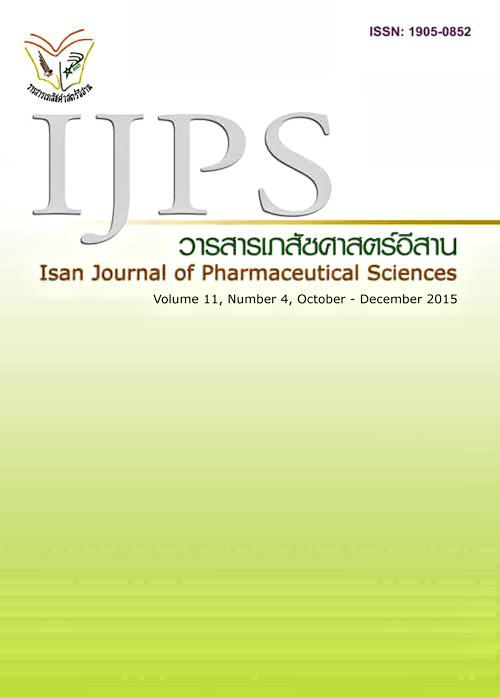Ertapenam Use Pattern and Utilization Volume and Susceptibility Rate of E. coli ESBL and K. pneumoniae ESBL to Ertapenem in Mahasarakham Hospital
Main Article Content
Abstract
Introduction: In 2014, Ertapenem expenditure was the second of in-patient drug expenditure in Mahasarakham hospital. This study aimed to determine Ertapenem use pattern and utilization volume and drug sensitivity in Mahasarakham hospital. Methods: A retrospective study was conducted from Mahasarakham hospital database. Ertapenem use pattern was reviewed from 6-month medication records during October 2013-March 2014. Utilization volume and drug sensitivity were retrieved from 4-year data during 2011-2014. Results: Of 185 patients receiving Ertapenem in 6 months, most of them were male (58.4%), aged 60+15.5 years and admitted in surgical department (81.1%). For pattern of use, 81.6% were empirical therapy and 18.4% were specific therapy, which were used for E. coli ESBL treatment (11.9%). Ertapenem use was increased from 10.90 DDD/1,000 patient-days in 2011 to 18.76 DDD/1,000 patient-days in 2014. During the 4-year period, susceptibility rates of Ertapenem for E. coli ESBL and K. pneumoniae ESBL were declined. Conclusion: Ertapenem use in Mahasarakham hospital is increasing and mostly empiric therapy. The hospital should enact a policy to control Ertapenem use and promote rational drug use.
Article Details
In the case that some parts are used by others The author must Confirm that obtaining permission to use some of the original authors. And must attach evidence That the permission has been included
References
Department of Pharmacy, Mahasarakham Hospital. Report of drug use value in 2014. Department of Pharmacy, Mahasarakham Hospital, 2014.
Gesser RM, McCarroll K, Teppler H, Woods GL. Effi cacy of ertapenem in the treatment of serious infections caused by Enterobacteriaceae: analysis of pooled clinical trial data. Journal of Antimicrobial Chemotherapy
; 51: 1253–1260.
Keating GM, Perry CM. Ertapenem: a review of its use in the treatment of bacterial infections. Drugs 2005; 65(15): 2151-78.
Lim CL, Lee W, Lee AL, Liew LT, Nah SC, Wan CN, et al. Evaluation of ertapenem use with impact assessment on extended-spectrum beta-lactamases (ESBL) production and gram-negative resistance in Singapore General Hospital (SGH). BMC Infect Dis. 2013 Nov 6; 13:523.
McLaughlin M, Advincula MR, Malczynski M, Qi C, Bolon M, Scheetz MH. Correlations of antibiotic use and carbapenem resistance in enterobacteriaceae. Antimicrob Agents Chemother. 2013 Oct; 57(10): 5131-3.
Merck Sharp & Dohme Corp. Prescribing information: INVANZ, ertapenem for IV or IM injection. Merck Sharp & CO., Inc., Whitehouse Station, USA, 2013.
National Drug System Development Committee. National List of Essential Medicines 2013. Nonthaburi: National Drug System Development Committee. 2013
Rodriguez-Osorio CA, Sanchez-Martinez CO, Araujo-Melendez J, Criollo E, Macias-Hernandez AE, Ponce-de-Leon A, Ponce-de-Leon S, Sifuentes-Osornio J. Impact of ertapenem on antimicrobial resistance in a sentinel group of Gramnegative bacilli: a 6 year antimicrobial resistance surveillance study. J Antimicrob
Chemother. 2015 Mar; 70(3): 914-21.
Sousa D, Castelo-Corral L, Gutiérrez-Urbón JM, Molina F, López-Calviño B, Bou G, Llinares P. Impact of ertapenem use on Pseudomonas aeruginosa and Acinetobacter baumannii imipenem susceptibility
rates: collateral damage or positive effect on hospital ecology? J Antimicrob Chemother. 2013 Aug; 68(8): 1917-25.
WHO Collaborating Center for Drug Statistic Methodology. ATC/DDD Index [Online]. 2013 Dec 19 Available from: http://www.whocc.no/atc_ddd_index/?code=J01DH03


